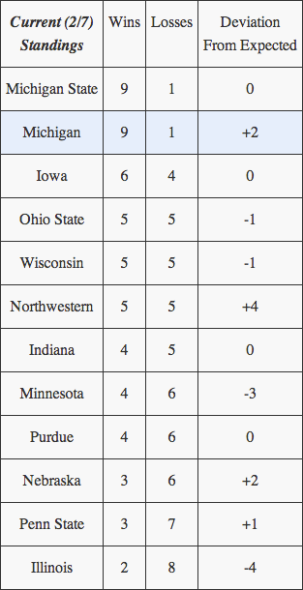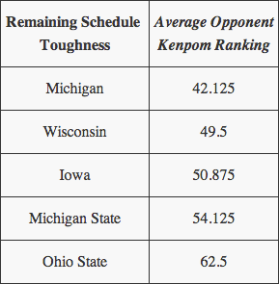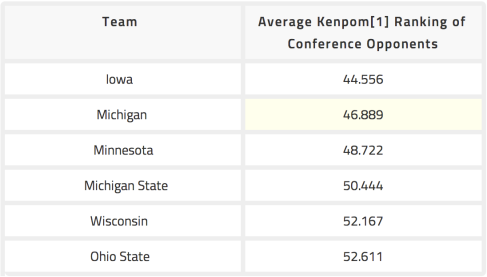Final Big Ten Standings (and analyzing where the favorites went wrong)
As predicted, the Michigan Wolverines and the Michigan State Spartans occupied the top of the conference for most of the year. Not including a non-conference loss to Georgetown, Michigan State stumbled down the stretch to close their regular season to the tune of a 5-6 record. By giving the Spartans two of those losses to sweep the season series, Michigan clinched the regular season title.
Meanwhile, Wisconsin fell off the pace in the early portion of the season and seemed to lose the momentum that prompted the best start in their school’s history. But an eight-game winning streak brought them from 4-5 to 12-5 in conference with a chance to claim 2nd place outright in the final game of the season. A loss on the road to the suddenly stingy-at-home Nebraska Cornhuskers ended those hopes. Without further ado, here are the final standings for the 2014 Big Ten basketball season and how the results compared to my predictions:
Some teams played with lower variance from the expectation (both good and bad), finishing with six or less “unexpected results” and finishing within one game of their final expected standings. Teams in this category include: Michigan, Minnesota, Indiana and Purdue. While no one outside of West Lafayette, Indiana likely expected more from this Purdue Boilermaker team, a veteran coach Matt Painter surely has to be disappointed in Purdue’s performance. Minnesota, on the other hand, had tournament aspirations dashed after some head-scratching losses and only two wins on the road in conference.
On the crazy side, some teams wildly traversed through their seasons, finishing with eight or more unexpected results – and naturally with mixed consequences – including: Ohio State, Wisconsin, and Northwestern. At the bottom of the conference, Northwestern impressed early in the year with surprising wins against Illinois, at Indiana, at Wisconsin, and at Minnesota, but they soon returned back to Earth with losses at home to Nebraska, Minnesota and Penn State. The Wildcats finished two games above their expectations at 6-12, surprisingly performing better on the road (4-5) than at home (2-7).
Illinois is another team that exhibited this superior road performance phenomenon, but a 4-5 away record vs 3-6 home record advantage is hardly indicative of some underlying talent on the road. Despite starting with high expectations for themselves, they finished an inconsistent season two games under my already-lowered expectations.
Projected at the start of the conference portion of the schedule to finish near the top of the conference, Ohio State had an abysmal season by Thad Matta’s standards, finishing three games below expectations. This was largely due to Craft & Co consistently failing to hold home court and losing both chances they had against Penn State. Wisconsin’s conference season was a mixed bag but they finished right in line with expectations. By tying for 2nd in the conference during the regular season, Bo Ryan’s streak of leading Wisconsin to a top 4 finish in the Big Ten is extended to a remarkable 13 years…sigh.
Here are the Home-Away splits for each team:
Michigan out-performed my expectations by one game – largely a product of their league-best 7-2 record on the road. However, finishing with an 8-1 home record is what really clinched the Big Ten Regular Season Conference title. The home loss for the Wolverines came against Wisconsin, as the Badgers avenged their home loss in the first meeting between the teams in Madison, Wisconsin.
As a quick side note, Michigan beat Nebraska 71-70 in Lincoln, Nebraska early in the season on January 9th, making them the only team to win on the road at Nebraska in conference play. Nebraska was 0-2 at the time, well on their way to an 0-4 and subsequently 1-5 start. That means they finished the last twelve games of their season 10-2! Who saw that coming??
For a blast into the past, check out this article by Jason King published on ESPN back in August of 2012, only a couple months after Nebraska hired Tim Miles: http://espn.go.com/mens-college-basketball/story/_/id/8225419/all-access-recruiting-nebraska-coach-tim-miles-men-college-basketball.
King shadowed Tim Miles on his first summer on the Nebras-ketball recruiting trail, writing an excellent piece that showed the rigorous timeline Miles held himself to. After reading the article in 2012, I recall being impressed by both Miles’s friendly demeanor and competitive tenacity, and more so how they could exist simultaneously.
Plenty of people expected a turnaround after seeing Miles’s track record at North Dakota State and Colorado State University. But very few expected it this fast. Almost two years after his hiring, Nebraska stole the role of Big Ten breakout basketball team of the year from Iowa, who slipped to three games under my expectations. Supporters of TIm Miles have to be growing in number every day, and the group of people who decided to hire him have to be smiling even brighter than before.
Let’s get a better look at how the top of the conference shook out. In the following table, the individual unexpected results are shown for the top half of the conference, consisting of the pre-season favorites plus Nebraska.
While Wisconsin played to my expectations, fellow pre-season favorites Michigan State, Ohio State, and Iowa each underperformed by three games for different reasons.
The formula is very clear: hold home court and travel solidly. Iowa failed to hold home court, and only stole a few wins on the road over similar under-performers. Retroactively looking, their schedule was probably the toughest since their one-plays were against Purdue and Nebraska at home, and Penn State and Indiana on the road. Missing a chance to play those teams a second time hurt their chances this year.
Ohio State had problems extending well into every aspect of their game. Similar to Iowa, they did not travel particularly well, going 4-5 on the road. Three losses at home is not a death sentence, but it becomes one when one of those losses is the first half of a season sweep to Penn State.
Michigan State struggled against its fellow top competition during the regular season, going 0-4 against the group of teams that make up the top 4 in the conference and going 1-5 against the top 5.
(click chart to embiggen)
At the end of the Big Ten regular season, the Michigan Wolverines are your champions by a full 3 games!













